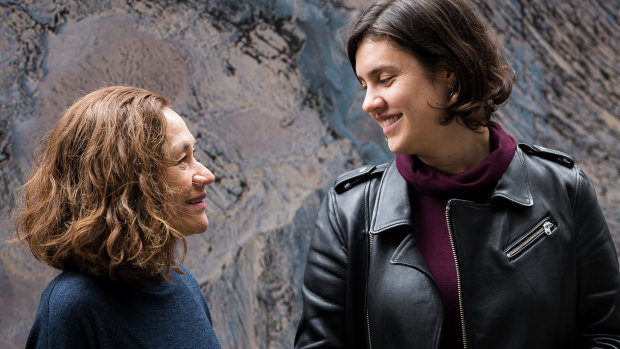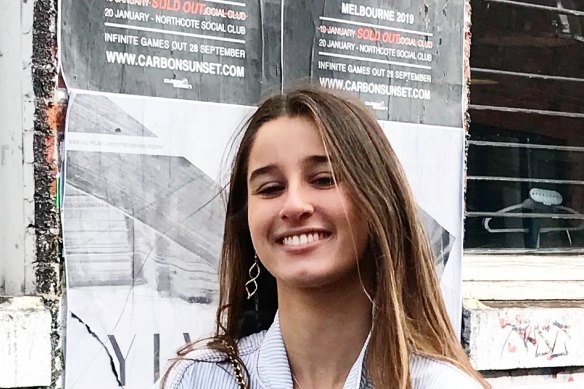This was published 4 years ago
Opinion
What curriculum says about consent isn’t necessarily what’s taught in classrooms
By Georgia Carr
The year I was born my mum, Dr Melissa Kang, began her 23-year stint as the medical consultant for the popular Dolly Doctor column in Dolly magazine. She tells me that throughout her entire time advising on the column young people were asking about consent, and calling for better consent education.
They didn’t always use the word “consent”. A more typical question might be along the lines of, “Hey I recently got into a relationship with a boy… I am not ready [to have sex] yet …He said he won’t pressure me into doing things I don’t want to do but I’m not too sure. What should I do?” But consent was at the heart of many queries.

Teens were asking Dr Melissa Kang (left) about consent long before her daughter Georgina Carr began reseaching it as part of her work as a sex education researcher.Credit: Shane Lo
I am now doing a PhD on sex education, and consent is among my areas of study. Following allegations of sexual assault and harassment in Parliament House and Australian private schools, it is clear the need for more teaching about consent is as great as it was when my mother wrote for Dolly. We are right to be asking when and how we should teach consent education.
I have sat in school sex education classrooms and seen teachers doing a phenomenal job. They are confident, unembarrassed, and knowledgeable about their topic and their students’ lives. They teach consent in great detail, from legal definitions to enthusiastic consent to how to access help if something does go wrong, and their students take these principles and apply them to scenarios involving questions of age, alcohol consumption and online bullying. But not every student sits in this kind of classroom.
Taught properly, schools are the best place for sex education. The evidence shows strong improvement not only in things like the use of condoms and contraception from school sex ed, but also social outcomes like better knowledge and acceptance of diverse sexualities and, crucially, better attitudes around consent and gender-based violence.
Even though almost 80 per cent of young Australians use the internet to find answers, they still rate school programs as one of the most trusted sources of sexual health information, competing with “mum” for first place in the five national surveys conducted to 2013.
Consent education is generally assumed to mean (1) consent to sexual intercourse and (2) the legal definition of consent. While both of these should be part of consent education, they also only scratch the surface.
Consent is something that exists beyond sexual intercourse. It applies in all sexual encounters, from kissing to touching to sexting, and students can learn about how to seek and express consent even if they are not interested in sex yet. But consent also applies outside of sexual contact altogether. It applies when you ask a friend’s permission to borrow their car, or when you offer to make them a cup of tea. The concept of consent can be taught even to young children: “Do you want to give grandma a hug or wave goodbye?”
In 2018, sex educator Deanne Carson was mocked for suggesting people can model consent with babies when changing a nappy, but bodily autonomy and respect are exactly the kind of values we should be raising children with. If 8 per cent of children experience sexual abuse before their 15th birthday and 28 per cent of students experience unwanted sex by the end of high school, former Kambala student Chanel Contos was right to say that learning about consent in year 10 is too late.
Consent education also often focuses on legality – at what age and under what circumstances sexual activity is legal or illegal. We are right to educate students on this, but knowing the legal definition of a term does not on its own change behaviours, any more than saying it is illegal to consume alcohol before the age of 18 stops underage drinking. Consent education must also include understanding the fundamental principles that underlie those laws – bodily autonomy, mutual respect, and enthusiasm and willingness rather than the absence of a “no”.

Chanel Contos, whose online petition calling on people to come forward with allegations of sexual assault, is forcing schools to change.
The Australian Curriculum on health and physical education includes topics on respectful relationships, including negotiating consent, managing relationships online and offline, and dealing with relationships when there is an imbalance of power. At the state level, consent is mentioned as early as Stage 1 (years 1-2 in the NSW syllabus), including learning the meaning of “private” and distinguishing between appropriate and inappropriate touching. “Consent” as it refers to sex appears later, in years 7-10, as part of negotiating safe intimate relationships. But what the curriculum says is not necessarily what goes on in the classroom.
Curricula will necessarily be quite general: they are designed to be flexible enough to meet the needs of different states and territories, local communities, and individual schools and teachers. This is of course an advantage, but it also means that there is the potential for great variability in how sex education is taught between and even within schools. Even though up to 90 per cent of students receive sex education in years 7-10, it’s much more likely that that covers the risks of sex such as STIs and unwanted pregnancy. It’s much less likely to cover consent, pleasure and LGBTQIA relationships, which is why students have been asking for them for years.
Ultimately, what happens in a classroom will be determined by the teacher in the room. Teachers consistently report a lack of time and resources, and are understandably left feeling underprepared. They may also feel embarrassed or fear backlash for discussing a topic that attracts controversy. We need only look at the political firestorm around Safe Schools in 2016 to understand why teachers might be hesitant to wade into politicised waters. Given the choice, and a chronic lack of time and resources, teachers understandably stick with what fits with their existing beliefs, interests and practices.
If governments and schools are serious about consent education, and are listening to what students have been saying since the days of Dolly magazine, they need to give sex educators the resources to have those conversations early and often. We need to get into actual sex education classrooms and make stellar teaching practices the norm. Only then will we see fewer stories like those in the headlines in the last few weeks.
Georgia Carr is a doctoral candidate at the University of Sydney.
Start your day informed
Our Morning Edition newsletter is a curated guide to the most important and interesting stories, analysis and insights. Sign up here.